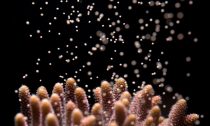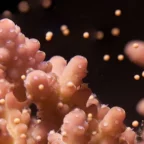
All coral reefs start off as a single polyp. A polyp is essentially a small tissue from the surface inside the body, somewhat similar to a sea anemone. Stony coral species live in colonies and discharge calcium carbonate, which acts as an external skeleton. Like jellyfish and sea anemone, which are their relatives, coral polyps have tentacles that are used to catch food. The tentacles are tucked away during the day, but reach out to catch their prey, mainly plankton, by stinging them.
On an annual basis, coral reefs release their gametes (reproductive cells) simultaneously. This phenomenon is most likely prompted by the right phase of the lunar and solar cycles as well as optimum water temperature. Millions of eggs and sperm rise to the surface and undergo fertilization – turning the ocean into a bright blizzard-like setting which can sometimes be seen from space!
However, due to the rise in water temperatures and ocean pollution, the timing of the release of gametes in some coral species has shifted and some corals are spawning out of sync. This has been attributed to the rise in water temperatures and ocean pollution. Missing the window by a few minutes can lead to lower fertilization rates, while missing the window by hours or days suggests that individual corals are unable to fertilise. The threats climate change poses to synchronized coral spawning have not been studied, but its links to global warming and coral bleaching have been well established.
Corals can reproduce asexually and sexually. When a coral reproduces asexually, new clonal polyps bud off from their respective parent polyps and begin to expand and establish new colonies. Most stony coral species are broadcast spawners, which means they release a plethora of eggs and sperm into the water, distributing their offspring over a large area. The eggs and sperm form planktonic larvae called planulae by means of fission. Once the planulae are formed, they swim back down and settle on a site consisting of its favourable conditions and will form colonies which will progressively become larger.
This phenomenon occurs over the course of a few days or a week. This is done because different species will release their gametes on different days in an attempt to prevent the hybridisation of species. This opens up the possibility of the use of evolved reproductive strategies by the corals, which, if studied to a further extent, could help us understand the science behind the ‘blizzard’.
Since colonies may be separated by long distances, the timing of the release of gametes must be precise, and usually occurs in response to various environmental cues or stimuli. The spawning occurs with respect to temperature, day length and the rate at which temperature changes. While the date of spawning depends on the lunar cycle, the minute at which this event occurs is set by the solar cycle. This exposes the topic to a myriad of questions, such as how do these simple yet amazing creatures manage to tell the time of the lunar month and sunset, with only a simple nerve net and no specialized organs?
Inside the body of a coral are highly productive algae. The algae use carbon in the water and energy from the sun to photosynthesise, and as a result the algae give approximately 95 per cent of this produced energy to the coral. In return, the algae get its essential intake of nitrogen to thrive. This is an example of a symbiotic relationship, and an example of a delicate communication process between the algae and the coral. For this, the algae have to constantly remind the coral that they belong there, and essentially tell the coral to ignore its presence. Otherwise the coral would consider the algae to be a parasite or an invader, and attack and kill it.
If the algae growth does get out of hand, the coral will send out a ‘distress call’, a chemical which will attract the Gobi fish. This allows the Gobi fish to eat as much of the algae as the coral wants. In protected areas where fishing is non-existent, coral reefs thrive. However, where there is overfishing, the coral reefs wither and die.
A further understanding about the timing and synchrony of coral spawning is not only beneficial for understanding the ecology of coral reef ecosystems, but the management side as well. There is a deficit with respect to data regarding timing of spawning from many coral reefs, particularly from equatorial regions. To understand this phenomenon, further research should be undertaken. Perhaps there is more to it than what meets the eye, like the use of telepathy or a particular wavelength of signals, a revolutionary form of evolved communication.
Corals are under increasing stress due to climate change, thermal stress, and light pollution. Protecting coral reefs should be as much of a focus of sustainable development as anything else. Future generations have every right to experience this little explored, least understood, beautiful aspect of nature, one that may even be supporting human lives in ways we do not comprehend.














Social Profiles